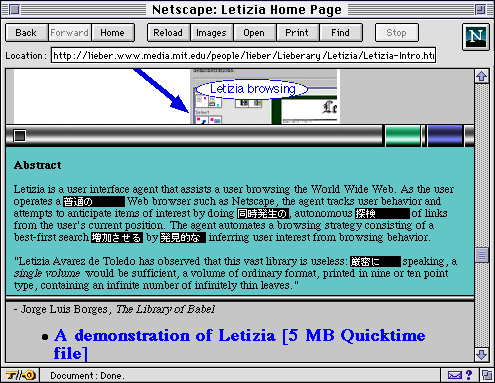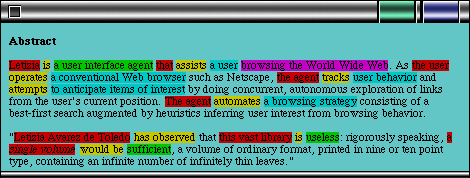
by Hiroaki Takatsuki <tsuki@deken.hitachi.co.jp>
In these days we have received benefit from the sea of information with the popularization of the World Wide Web (WWW). From the vast information, to find valuable bits is definitely one of serious problems.
However, to understand written English, a practical official language on WWW, is also an important problem for the people whose mother tongue is not English, especially, for the people whose mother tongue has a different origin from Latin, like Japanese.
To understand written English we usually use a dictionary. Recently we are able to use various types of dictionaries, for example, electronic dictionaries, dictionary software, on-line dictionaries, and so on. Those dictionaries provide us with a quick search function, but those are merely a kind of the conversion from atom to bit, and there is no significant difference between the "atomic" dictionary and the digital one in the basic concept. Therefore, the dictionaries don't choose an appropriate meaning from choices (especially if the word is a part of an idiomatic expression, we often have a trouble with understanding the real meaning), and the dictionaries also don't tell us the part of speech of the word. I recognize that the dictionaries are valuable to us as a bridge between two culture. However, the concept or the function of dictionaries should be revised with new technology.
As a solution we can use some translation programs. Those programs seem convenient. However, I think, the use of those kinds of programs may obstruct user's progress in understanding English.
In this project I tried to propose a reading assistant for the people who learn English as a second language using the software agent technology to solve the problems that the present dictionaries have.
The agent should have a model of user's ability in understanding written English, and should show not only the meaning of words or idioms, but also the structure of the sentence and other useful information based on the user's level. I assume that this reading assistant is mainly used with a Web browser or other programs.
When we don't understand a sentence, I think there are three problems.
- don't know the meaning of words or idioms
- can't understand the structure of the sentence (can't specify the part of speech of words)
- don't have knowledge that native readers usually have as a kind of common sense
The information to be explained to the user is different in each problem, but these problems are related each other. For example, "champion" is a well known word as a noun (nowadays the word, "champion", is more popular than Japanese word that has the same meaning), but the word is sometimes used as a verb. The user may know the word, but if he misunderstands the structure of the sentence, or misunderstands the part of speech of the word, he must be confused. This problem is also seen in the sentences that use some idiomatic expressions.
The problem that is related to a kind of common sense is very difficult. For example, I would not understand some jokes about TV programs, the Presidents, baseball players, tax problems, and so on, because I don't have much knowledge that American people usually have. To understand language is to understand the culture or the life in the country., therefore, the reading assistant should also explain those kinds of "common sense." However, this problem is too difficult to solve in this project, so I would like to focus on the first two problems.
Figure 1 shows a sample window of AAD in Japanese meaning mode. In this situation the AAD is used on the Netscape Navigator. This AAD window is always on the active window. Every position of the AAD window on each program should be stored separately.

Figure 1 a Sample Window of AAD in Japanese Meaning Mode (Original Web Page is "http://liever.www.media.mit.edu/people/lieber/Lieberary/Letizia/Letizia-Intro.html" by Henry Lieberman.)
Figure 2 shows function of AAD window. The AAD window is consisted of three parts: Slide Bar, Lens Area, and Resize Bar. On the Slide Bar there are three buttons: Close Button, Meaning Button, and Structure Button. I assume that this AAD is a kind of application programs. So to start the AAD is done with double click the icon of AAD. To close the AAD is done with one click on the Close Button. Basically the horizontal position of the AAD is fixed, or automatically expanded as much as it can, therefore, we can only move the window vertically with the Slide Bar. The resize of the window is done with the Resize Bar. To display Japanese meaning of words is done with clicking the Meaning Button, and to display structure of sentence is done with clicking the Structure Button (Figure 3 shows a sample of the structure mode).
The unknown words are basically suggested by the agent. However, users can add/remove unknown words with clicking words in the Lens Area. To do this affects user model that the agent has. Now I don't have any concrete ideas about the user model, but I assume that words are basically categorized with situations in our life or research areas, and with level of difficulty, and the agent has a numerical evaluation in each category.
Figure 3 shows a sample AAD window in the structure mode. In this mode, users can see parts of speech, like subject, object, verb, and so on. Here subjects are represented in red, and verbs are represented in yellow.

Figure 2 Explanation of the Function of AAD Window

Figure 3 a Sample AAD Window in Structure Mode
This AAD could be a new interface of electronic dictionary. Especially, I think, it is useful that the meanings and the unknown words are displayed at the same position. However I found many problems.
- how to choose an appropriate meaning
- how to represent Japanese meanings when the width of words is wider than the one of original English words
- how to represent Japanese meanings of idioms
- how to tell a user that a word that a user removes has a difficult or different meaning
- the representation of structure of sentences is not appropriate (especially, it can not tell a user relations between noun and (relative) pronoun)
Moreover, in this paper I don't mention about the problems related to "Common Sense," but that problem must be the most difficult problem. For example a word, "agent," means a kind of software program, however, it could be possible to be thought that it is a person by a user. To prevent that problem, AAD should have additional window to display those kinds of information. Another window of Web browser might be a solution.
Even though there are many problems, I believe that this lens like interface could expand our ability like eye-glasses that we wear to correct our sight.
Last modified : April 18, 1997